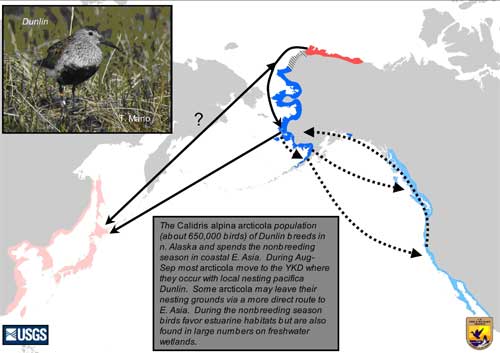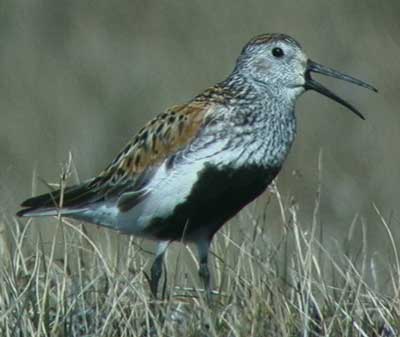Dunlin, Calidris alpina arcticola
High-Priority Species ListBreeding
The total population of arcticola is estimated at 750,000 birds (Brown et al. 2001), although a more realistic number may be closer to 200,000-300,000 (Wetlands International-Oceania 2004). The only place in Alaska where arcticola Dunlin are known to occur in isolation of the pacifica subspecies is the North Slope. Breeding arcticola Dunlin are found in good numbers throughout the National Petroleum Reserve - Alaska (NPR-A) and east to the western edge of the Arctic National Wildlife Refuge. High densities have been reported at Barrow and Prudhoe Bay (Troy and Wickliffe 1990, R. Lanctot, unpubl. data); nest densities in these areas average between 12 and 15 nests/km2. Additional areas within the NPR-A also have high densities based on surveys conducted in the late 1990s and early 2000s (J. Bart, unpubl.). Somewhere in the vicinity of Point Hope, it is suspected that the breeding areas of the arcticola and pacifica subspecies overlap (R. Gill, pers. comm.), although genetic and morphological studies have not been conducted to confirm this hypothesis.
Post-breeding
Thousands of arcticola Dunlin stopover along the North Slope coast after breeding (Andres 1994). They were the most common shorebird on the Colville River delta during fall surveys in 1987 and 1988, with an average of 13.9 birds/km of shoreline and an average density of 71.9 birds/km2 (Andres 1994). Surveys in the same area in 2005 also indicated Dunlin were present in large numbers during late August (1,075 birds/km2 on 21 August survey); these birds were primarily adults with 3:1 adult to juvenile age ratio (Johnson et al. 2005). Significant numbers of Dunlin also frequent coastal sites near Elson Lagoon at Barrow and the Canning River delta (Martin and Moitoret 1981, Taylor et al. in press). After leaving the North Slope, a sizeable portion (or all?) of arcticola Dunlin migrate to the outer Yukon-Kuskokwim Delta to stage in August and September. Here they mix with pacifica Dunlin and form huge aggregations, numbering in the tens of thousands (Gill and Handel 1981, 1990). Large aggregations are present from Hooper Bay south to the Kuskokwim River (Gill and Handel 1990; R. Gill and B. McCaffery unpubl.). Dunlin leave the YKD for Asia in September or early October.
Sampling locations: Breeding arcticola will primarily be sampled on the North Slope at established camps at Barrow, Canning River, Teshukpuk Lake, Prudhoe Bay, and surrounding areas. Secondary post-breeding locations on the North Slope will be Elson Lagoon, the Colville River delta, Kaktovik, and Peard Bay. Secondarily, post-breeding birds will be sampled on the central and southern YKD (Tutakoke and Kuskokwim Shoals, respectively).
Sampling timeframe: Breeding birds will be sampled during June and July on the North Slope; post-breeding birds will be sampled during August and early September on the North Slope and YKD.
Sample demographics: Adults will be sampled during breeding, and adults and juveniles will be sampled during fall staging.
Methods of capture: Birds breeding on the North Slope will be live-trapped on nests using walk-in and bow traps. Post-breeding birds on the North Slope and YKD will be live-trapped using bow traps, walk-in traps, mist nets, and/or rocket nets. Fecal sampling will occur at both areas during the post-breeding period at high tide roost or from areas where birds were observed feeding.
Ability to capture birds: Breeding locations: As part of a shorebird community breeding ecology study, arcticola Dunlin were captured at Barrow in 2001 and 2003-2005 (R. Lanctot, unpubl.). During this time, 275 adults and 307 chicks were captured. We anticipate higher numbers of birds to be captured in the coming year as biologists focus on this one species. We also anticipate similar to higher capture rates to occur in other breeding locations where similar densities have been documented. Post-breeding locations: In 2005, 36 Dunlin were captured at Barrow (18), Colville River delta (10) and Peard Bay (8) during a study investigating the post-breeding ecology of shorebirds (Taylor et al. in press). Dunlin were not targeted during this study, and it is expected that a larger number could be captured. Since the mid-1970s there have been several efforts to capture post-breeding Dunlin on the YKD resulting in over 3,000 birds being processed, including over 600 in 2005 (R. Gill, unpubl.). Most birds were captured at high tide roosts with rocket nets, but mist nets and walk-in traps were also used.
Other targeted species: At the proposed primary breeding sites it will be possible to sample small to moderate numbers of Long-billed Dowitchers, Pectoral Sandpipers, and Buff-breasted Sandpipers. On the post-breeding locations on the YKD it will be possibly to sample moderate to large numbers of Rock Sandpipers and Sharp-tailed Sandpipers, and small numbers of Bar-tailed Godwits, Pectoral Sandpipers, and Long-billed Dowitchers.
Contact: Richard Lanctot
Yukon Delta NWR
U.S. Geological Survey
Contact: Robert Gill
Brown, S., C. Hickey, B. Harrington, and R. Gill (eds.). 2001. The U.S. Shorebird Conservation Plan, 2nd ed. Manomet Center for Conservation Sciences, Manomet, MA.
Gill, R. E., Jr., and C. M. Handel. 1981. Shorebirds of the eastern Bering Sea, p. 719-738. In D. W. Hood and J. A. Calder (eds.) The eastern Bering Sea shelf: Oceanography and resources. Vol. 2. Univ. of Washington Press, Seattle.
Gill R. E., Jr., and C. M. Handel. 1990. The importance of subarctic intertidal habitats to shorebirds: a study of the central Yukon-Kuskokwim Delta, Alaska. Condor 92:702-725.
Johnson, J., T. McKinnon, and B. Andres. 2005. Summary Report: Autumn Migration at the Colville River Delta: Arctic Coastal Plain, Alaska, 25 July-23 August 2005. Unpubl. Report by U.S. Fish and Wildlife Service.
Johnson, J. A., R. B. Lanctot, B. A. Andres, J. R. Bart, S. C. Brown, S. J. Kendall, and D. C. Payer. In review. Distribution of breeding shorebirds on the Arctic Coastal Plain of Alaska. Arctic.
Martin, P. D., and C. S. Moitoret. 1981. Bird populations and habitat use, Canning River Delta, Alaska. Report to Arctic National Wildlife Refuge by Alaska Cooperative Wildlife Research Unit and Dept of Biological Sciences, University of Alaska Fairbanks.
Norton, D. W. 1971. Two Soviet recoveries of Dunlins banded at Point Barrow, Alaska. Auk 88:927.
Taylor, A. R., A. N. Powell and R. B. Lanctot. In press. Pre-migratory movements and physiology of shorebirds staging on Alaska’s North Slope. OCS Study MMS 2006-xxx, Annual Report No. 11, Federal Fiscal Year 2005, pages xxx-xxx.
Troy, D. M. and J. K. Wickliffe. 1990. Trends in bird use of the Pt. McIntyre Reference Area 1981-1989.Unpubl. report by Troy Ecological Research Associates for BP Exploration (Alaska) Inc.
U.S. Interagency Strategic Plan. 2006. Final Draft: An early detection system for Asian H5N1 highly pathogenic avian influenza in wild migratory birds.
Warnock, N. D. and R. E. Gill, 1996. Dunlin (Calidris alpine). In The Birds of North America, No. 203 (A. Poole and F. Gill, eds.). The Academy of Natural Sciences, Philadelphia, and The American Ornithologists’ Union, Washington, D.C.
Wetlands International-Oceania. 2004. Science Action Plan for the Dunlin Calidris alpina in the East Asian-Australasian Flyway. Unpubl. report by Wetlands International-Oceania.

Ranking Score: 17.0
Asian H5N1 ranking criteria for Dunlin, Calidris alpina arcticola.
Total of partial contact with Asia1 |
Contact with known "hot spot"2 |
Habitat used in Asia3 |
Pop. in Alaska4 |
Can samples be obtained? |
Score |
5.0 |
2.0 |
3.0 |
4.0 |
3.0 |
17.0 |
Entire population winters from Taiwan north to Yellow Sea and n. Japan |
Winters throughout areas where H5N1 identified |
Uses estuarine and freshwater habitats; also ephemeral inland lakes where domestic waterfowl are raised |
Est. at 650,000 |
Relatively easy to trap on nests and during postbreeding when in flocks |

